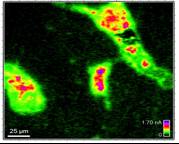Photoelectrochemistry
The photoelectrochemical techniques developed at the laboratory have recently found new takers in the nuclear field, in particular at AREVA (thesis by A. Loucif) and at the CEA-Saclay (2008-2009 research collaboration).
 | Micro-photoelectrochemistry : Signature of iron oxide nodules on oxidized stainless steel |
Acoustic emission
Acoustic emission (thesis by M-T. Tran, in collaboration with Euro Physical Acoustics) is an original technique in the corrosion and oxidation community. We are working to improve its use and on better link-ups with more conventional techniques. We are hoping that this work will lead to significant advances in the mechanisms of dissipative stages and, in particular, the signatures of phonon-producing mechanochemical phenomena such as cracking, detachment or flaking of an oxidation layer. The development or improvement of measuring techniques is of major strategic importance in leading-edge applications in the field of aqueous corrosion. In this respect, we have recently been chosen by the Rhône-Alpes Region (ENERGIES Research Cluster) to take forward the assessment of PEMFC stacks using non-invasive metrology by combining electrochemical noise and acoustic emission techniques (Prof. R. Nogueira, recently moved to LEPMI).
Adherence measurements
One of the SIR group's strengths is the development of specific experimental techniques for studying the mechanical stability of interfaces, by adapting to the system being studied (nature of the materials and dimensions). As part of a project concerning components in the presence of plasma, for example, a specific system was used for the monobloc geometry in order to exert shear on the link from different angular sectors. We have become an acknowledged specialist in this field as we are often approached for contributions or expert appraisals. Regular requests are received in particular for the swelling-detachment test from both research colleagues (Poitiers, Louvain, surgical glues) and from industry (Essilor, Arcelor Mittal).
Atomic force microscopy in liquid media
AFM in liquid media is used to study the charges liable to exist at the surface of functionalised materials such as the SiO2-TiO2 sol-gel composites that we have studied in the case of superhydrophilicity. For example, a TiO2 surface exerts only van der Waals type attraction whereas both SiO2 and composite SiO2-TiO2 surfaces exert repulsive electrostatic interactions that indicate the existence of negative surface charges (thesis by M. Houmard, 2009).


